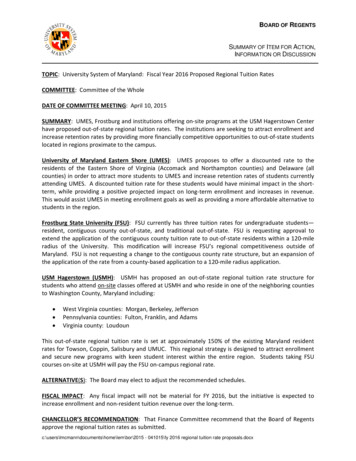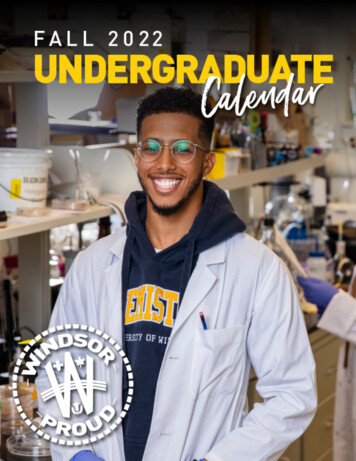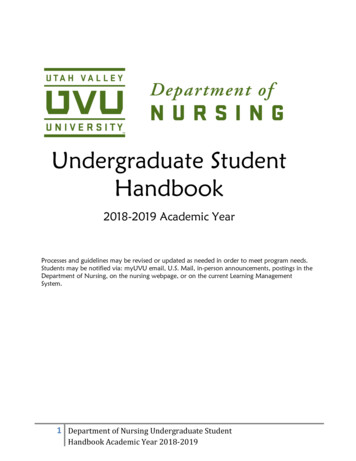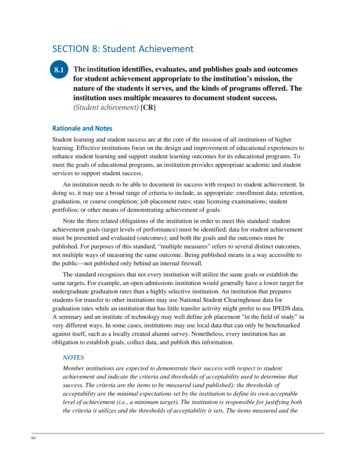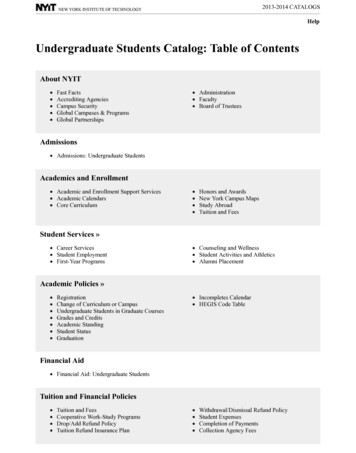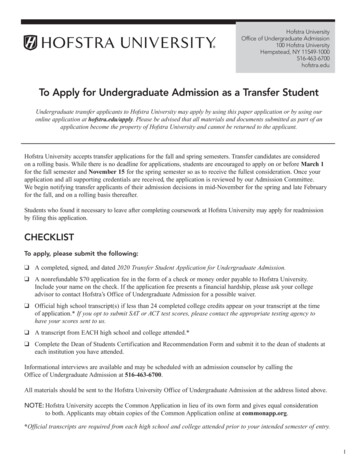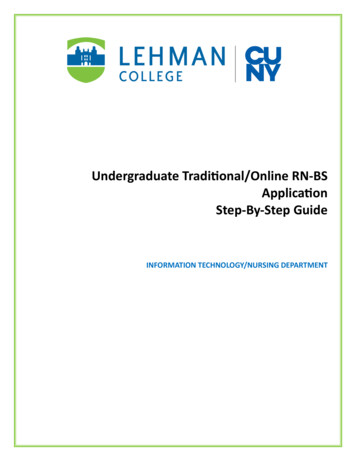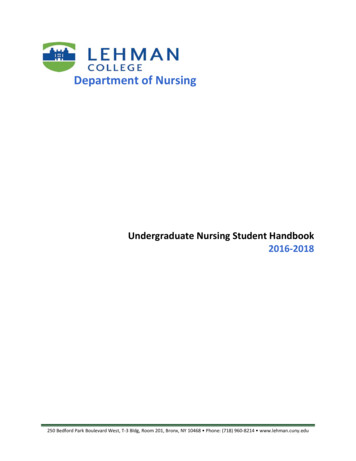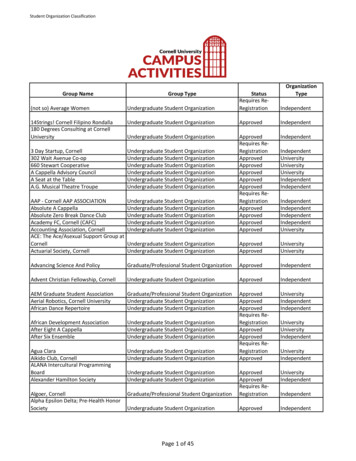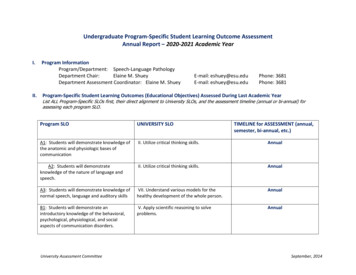
Transcription
Undergraduate Program-Specific Student Learning Outcome AssessmentAnnual Report – 2020-2021 Academic YearI.II.Program InformationProgram/Department: Speech-Language PathologyDepartment Chair:Elaine M. ShueyDepartment Assessment Coordinator: Elaine M. ShueyE-mail: eshuey@esu.eduE-mail: eshuey@esu.eduPhone: 3681Phone: 3681Program-Specific Student Learning Outcomes (Educational Objectives) Assessed During Last Academic YearList ALL Program-Specific SLOs first, their direct alignment to University SLOs, and the assessment timeline (annual or bi-annual) forassessing each program SLO.Program SLOUNIVERSITY SLOA1: Students will demonstrate knowledge ofthe anatomic and physiologic bases ofcommunicationII. Utilize critical thinking skills.AnnualA2: Students will demonstrateknowledge of the nature of language andspeech.II. Utilize critical thinking skills.AnnualA3: Students will demonstrate knowledge ofnormal speech, language and auditory skillsVII. Understand various models for thehealthy development of the whole person.AnnualB1: Students will demonstrate anintroductory knowledge of the behavioral,psychological, physiological, and socialaspects of communication disorders.V. Apply scientific reasoning to solveproblems.AnnualUniversity Assessment CommitteeTIMELINE for ASSESSMENT (annual,semester, bi-annual, etc.)September, 2014
C1: Students will be familiar with generalconcepts involved in the treatment ofcommunication disordersII. Utilize critical thinking skills.AnnualD1: Students will demonstrate the ability tocommunicate effectively in writing in termsof organization, semantics, syntax, spelling,and APA style.III. Communicate orally, in writing, andthrough other formats.AnnualE1: Students will demonstrate an ability tolocate and use appropriate informationsources.IV. Demonstrate information literacy andtechnological skills.AnnualE2: Students will display an introductorylevel of skill at using professional-relatedtechnology.IV. Demonstrate information literacy andtechnological skills.AnnualF1: Students will demonstrate maturity,dependability, and reliabilityI. Demonstrate an understanding of theirrole as citizens of a diverse, global society.AnnualF2: Students will demonstrate ethicalbehaviorI. Demonstrate an understanding of theirrole as citizens of a diverse, global society.AnnualIII. Communicate orally, in writing, andthrough other formats.AnnualI. Demonstrate an understanding of theirrole as citizens of a diverse, global society.AnnualF3: Students will demonstrate the abilityto work both independently and ingroups.F4: Students will demonstrate a desirefor continuing professional growth.University Assessment CommitteeSeptember, 2014
III. Direct Measures UsedUsing the table below, list and briefly describe the direct methods used to collect information assessing whether students arelearning the cores set of knowledge (K), skills (S) and attitudes (A) identified as essential.Dept. SLO#DirectAssessmentMeasure(s) UsedAssessment description(exam, observation,national standardized exam,oral presentation withrubric, etc.)Assessmentcompleted by(student,supervisor,faculty, etc.)When assessmentwas administered instudent program(internship, 4th year,1st year, etc.)To whichstudents wereassessmentsadministered(all, only asample, etc.)A1Neuro Final ExamComprehensive final examcovering neurological basesof communicationFaculty4th year SpringAllA2PsycholinguisticsTranscriptionQuizQuiz testing phonetictranscription of all AmericanEnglish soundsFaculty4th year SpringAllA2PsycholinguisticsFinal ExamComprehensive final examcovering the structure oflanguageFaculty4th year SpringAllA2PsycholinguisticsFinal GradeComprehensive finalpsycholinguistics gradeFaculty4th year SpringAllA3SLD Test 2Course examFaculty1st year SpringAllUniversity Assessment CommitteeSeptember, 2014
B1Intro toAudiology, FinalExamFinal ExamFaculty2nd or 3rd year FallAllC1Intro to ClinicAppliedAssignment,TreatmentStudent produces SOAP noteand therapy plan forhypothetical clientFaculty4th year SpringAllD1AnatomyDisorder TopicPaperPaper about an anatomicdifference that leads to acommunication disorderFaculty2nd or 3rd year FallAllE1Intro toAudiology,ResearchWorksheetResearch Worksheet,including peer reviewedarticlesStudent2nd or 3rd yearAllE2Speech ScienceAssignments 4, 7Lab AssignmentsFaculty2nd or 3rd year SpringAllF1SLD AttendanceClass attendance forsemesterFaculty1st year SpringAllF2Testing andMeasurement2nd or 3rd yearSpringAllCourse exams (all)FacultyF3Intro to ClinicAppliedAssignment,EvaluationStudents will interact tocomplete a writtenevaluation report of ahypothetical clientFaculty4th year SpringAllUniversity Assessment CommitteeSeptember, 2014
IV. Indirect Measures UsedUsing the table below, list and briefly describe the indirect methods used to collect information assessing whether students arelearning the cores set of knowledge (K), skills (S) and attitudes (A) identified as essential.Dept. SLO#IndirectAssessmentMeasure(s)UsedAssessment description(survey, alumni or employersurvey, national standardizedexam, non-gradedassignments, studentprojects – non-standardized,journals, opinion polls, etc.)Assessmentcompleted by(student,supervisor,faculty, etc.)When assessmentwas administered instudent program(internship, 4th year,1st year, etc.)To whichstudents wereassessmentsadministered(all, only asample, etc.)F4Membership incampusprofessionalorganizationsMembership countFacultyadvisorsAll years SpringAll those whoparticipatedF4Attendance atprofessionalconferencesCounting those who attendFaculty alsoattending theconferenceAll years, throughoutthe yearAll those whoattendedF4Application toand acceptanceat graduateschoolGraduate programapplications; student selfreportsFaculty(graduatecoordinator)and students4th year SpringAll who aregraduatingSee charts attached at end with data collected over time.University Assessment CommitteeSeptember, 2014
V.Student Performance OutcomesHow did the student perform on each assessment, compared to the department/program goal?What is the target/goal/score for each assessment? Then briefly summarize the results.Assessment number/nameTarget/Acceptable scoreNumber assessedin 2020-2021 (N)Number & % meeting target/Number and % not meeting targetA 1 Neuro Final Exam80%27Met: 21 (78%)Not met: 6 (22%)A 2 PsycholinguisticsTranscription Quiz70% target reduced becausestudents are tested oninformation from freshmanyear28Met: 25 (89.28%)Not met: 3 (10.62%)A 2 Psycholinguistics FinalExam80%28Met: 26 (92.85%)Not met: 2 (7.14%)A 2 Psycholinguistics FinalGrade80%28Met: 26 (92.85%)Not met: 2 (7.14%)A 3 SLD Test 280%35Met: 25 (71%)Not met: 10 (29%)B 1 Intro to Audiology FinalExamUniversity Assessment Committee80%26Met: 16 (61%)Not met: 10 (38%)September, 2014
C 1 Intro to Clinic AppliedAssignment, Treatment80%25Met: 25 (100%)Not met: 0 (0%)D 1 Anatomy Disorder TopicPaper80%23Met: 19 (82.61%)Not met: 4 (17.39%)E 1 Research Worksheet inAudiology80%26Met: 20 (77%)Not met: 6 (23%)E 2 Speech Science Assign. 4(4, measuring Fo, 7,measuring formants)80%27Assign 4, Met: 25 (92.59%)Not Met: 2 (7.4%)Assign 7, Met 27 (100%)Not Met: 0 (0%)F 1 SLD Attendance80%35Met: 29 (82.85%)Not met: 6 (17.14%)F 2 Testing andMeasurement100% integrity while takingtests32Met: 32 (100%)Not met: 0 (0%)F 3 Intro to Clinic AppliedAssignment, Evaluation80%25Met: 25 (100%)Not met: 0 (0%)F 4 Membership80 % of UG for NSSHLA100F 4 Attendance8 UG; 1G (any conference)0 UG; 3 GF4 Acceptance100 % of those applying26 appliedMet: 70 (70%)Unmet: 30 (30%)0 UG, 3 G conferences cancelled orheld remotely due to pandemicAccepted: 25 (96.15%)Not accepted: 1 (4%)University Assessment CommitteeSeptember, 2014
See charts at end of reportVI. Key Findings: Briefly summarize the results of the assessments and how do these compare to the goals you have set?It should be noted that UG classes were held remotely during AY 2020-2021. However, the CSD classes were held in real timeon Zoom. Classes were recorded and posted on D2L so that students could revisit them.Most goals were met.A1 Students found the comprehensive nature of the neuro final to be difficult.A2 Student performance on objective A2 met the level of competence targeted as a department goal. Students maintainedknowledge of phonetic transcription from a freshman year course to a senior course at 70% or better and demonstratedperformance at 80% or better on other measures. Overall mean scores were above the departmental goal for transcription quiz,final and final grade.A3 Performance in this class reflected a variety of issues, some related to the remote nature of the class. Only 1/3 of the classwere active learners. The other 2/3 had their cameras off and participated minimally. Some students were at work duringclass.B1 Performance on B1 is reflective of a greater number of underprepared students who are entering the major. That isreflected in their inability to expand their study skills and learn from earlier performance. They are resistant to using the tutorand writing lab. Similar issues are starting to be noted in other classes as well. The tutors have attended classes so students arefamiliar with them.E1 Incoming students have much varied experiences with writing papers. Despite having included one class on findingresources in the library, students struggled with finding resources, using peer-reviewed sources, and writing papers. To addressthis, attendance for two library classes was required. Students had to turn in their list of references early, then complete theresearch worksheets, then turn in the summary of their disorders, and then the final copy.University Assessment CommitteeSeptember, 2014
F4 Membership – the lower number of NSSHLA members is reflective of both reduced SPPA enrollment and an increase in thenumber of students who work extensive hours to support themselves, not allowing for attendance at meetings Meetings wereheld remotely during the pandemic, but activities were obviously limited by the lack of face to face opportunities.F4 Attendance – the attendance at professional meetings is clearly related to how far away the conference is (see chart).Students continue to be encouraged to attend conferences when they can afford it. All fall 2020 conferences were cancelleddue to the pandemic. Some spring 2021 conferences were held, usually remotely. Students did not attend in that format,except those who were presenting papers.F4 Acceptance – the acceptance rate has varied over time. Changes in advising, the encouragement of minors/concentrations(for alternate career paths), calculation of transfer GPA to include all sources, and the continuation of the structured GPAwarning letters have resulted in a stable acceptance rate, with some students leaving the major earlier to be more successful inother majors. Early admittance to students with 3.7 and above was initiated in AY 2018-29 and resulted in many students withthe highest GPAs staying at ESU. It should be noted that our accrediting agency has approved multiple new programsthroughout the country. Pennsylvania has gone from 14 programs to approximately 27. Existing programs have expressedfrustration about the number of programs, the increased competition for quality students, and the drastic effect this has had oninternship possibilities.VII. Describe Process Used by Program Faculty to Discuss and Interpret Key FindingsThrough what modes were assessment results shared with program faculty? What process was used by program faculty todiscuss and interpret the key findings? What hypotheses do program faculty have for why these are the results?Goals and outcomes are discussed as needed at departmental meetings throughout the academic year, but are specificallytargeted at the summer departmental meeting.Current discussions are centering on under prepared students who struggle in classes and often leave the major or theuniversity. Recommendations for help (tutoring, counseling, other support) are being made but often without follow throughby the students. Strong midterm advising has been encouraged while the student can still improve their performance. Thisincludes asking students to describe their plan for improving each low grade. Even with this, faculty often find themselves doingextensive remediation and explaining basic issues like: how to revise a paper/assignment that the faculty member has edited;University Assessment CommitteeSeptember, 2014
why students need to do more than take notes and memorize; and how performance is building an academic portfolio. Thepandemic only increased the issue.VIII. Changes Made as a Result of the Key Findings / Actions TakenWhat changes or actions were taken or are planned for 2021-2022 and in the future in response to your key findings?A1 The instructor will prepare a study guide for the comprehensive finalA3 In-person learning will prevent some of the attendance and participation issues that occurred via Zoom.B1 Increased use of the tutor and the establishment of additional review materials will be implementedE1 Despite the fact that the instructional sessions with the librarian were required, attendance was poor. Therefore, in futureclasses, a reward/penalty will be established regarding attendanceF4 Membership – students who cannot attend meetings are being encouraged to attend NSSHLA activities which are held atvarying times. That will give them the social, personal, and professional involvement that is the point of the organization. Thereturn to in-person learning also increases the number of events possible, which should attract more students.IX. Adjustments to/Deviation from the Department Assessment PlanDescribe any disparity from submitted assessment plan and why it occurred.None occurred.University Assessment CommitteeSeptember, 2014
Student Memberships and Conferences UAutismSpeaks30NationalNSSHLANESHAPPSHA5 UGNortheastPennsylvania32 UG4GHarrisburgASHAOther39 UG39 UGDeaf and Hard27 GPhiladelphia of HearingExpoHarrisburg201720188060371 ne14 UG3 tPittsburgh1GPennsylvaniacancelledOrlandoFall noneSpringcancelledNoneHeld remotely Washington DC1GMultiplerestrictions02020- 502021 MetregularlyviaZoom55Met biweekly viaZoom; didRemoteevents likecookingclassesUniversity Assessment Committee35Metregularlyvia Zoom14 UG3GPittsburgh1GLos Angeles1 UG, 1 PRInternationalConf onUnilateralHearing Loss,Philadelphia8 UGEvent atGallaudetUniversity1GEducationalAudiologyAssoc.1 G AsiaOceanicRehabConferenceSeptember, 2014
Both remoteGraduate School StatusAcademicYear# of StudentsGraduating# Accepted to % Accepted# Not% NotSLP/Aud GradtoAccepted toAccepted toProgramSLP/Aud Grad SLP/Aud Grad SLP/Aud GradProgramProgramProgram(of those who(of those whoapplied)applied)3183.78%616.22%# Who didnot apply toGradProgram# Who wentinto adifferent 20-2021292596.1514.00%21University Assessment CommitteeSeptember, 2014
Undergraduate Program-Specific Student Learning Outcome Assessment Annual Report - 2020-2021 Academic Year I. Program Information Program/Department: Speech-Language Pathology Department Chair: Elaine M. Shuey E-mail: eshuey@esu.edu Phone: 3681 Department Assessment Coordinator: Elaine M. Shuey E-mail: eshuey@esu.edu Phone: 3681 II.
